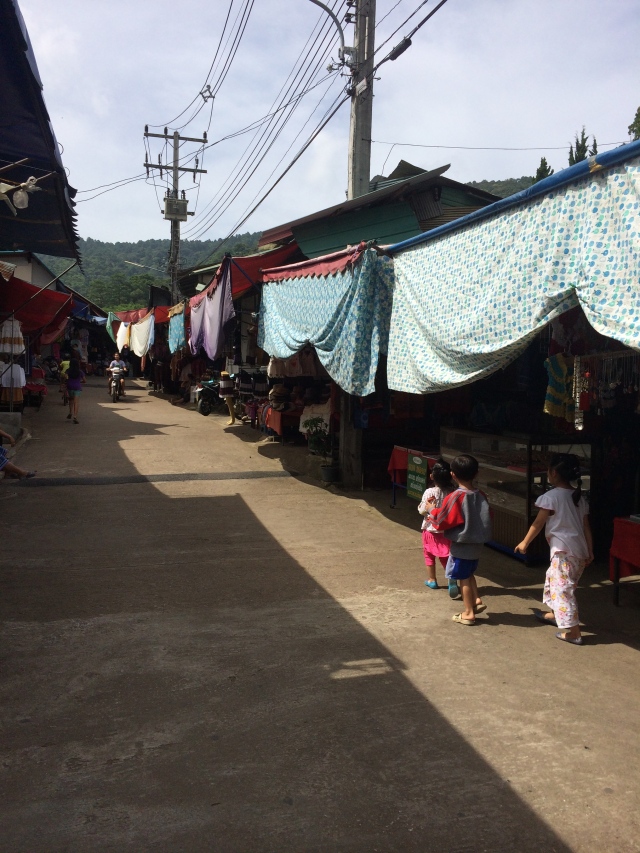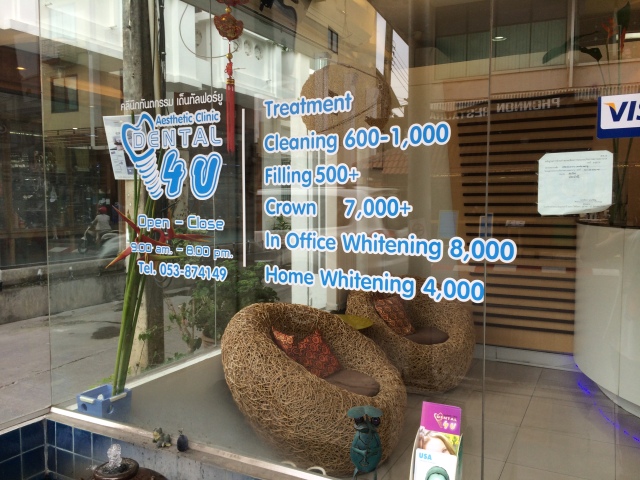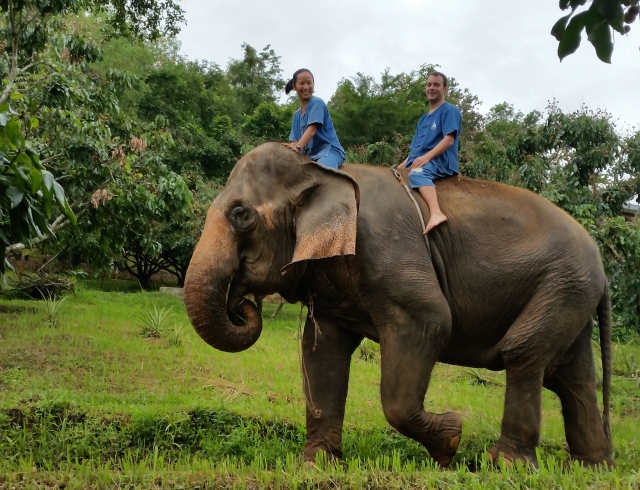With only four days in Chiang Mai, I felt obliged to plan an action-packed itinerary. If we had more time, I would have liked to spend at least a week in Chiang Mai, followed by several days in Chiang Rai. Upon looking at the calendar I saw that we had less than two months for the remainder of our Southeast Asia tour and I reluctantly booked our flights to Yangon, Myanmar on June 1.
Another sleepless overnight train left is longing for a nap and massage upon our arrival in Chiang Mai. It wasn’t until after a full day’s rest when we finally mustered up the energy to wake up at 6 or 7am the next three days for our packed schedule of events. Fortunately, since Chiang Mai is nestled in the mountains in Northern Thailand, the temperatures are cooler and much more tolerable.
On our first day, we rented a motorbike for 180 baht (~$5.50 USD) and set out for Tiger Kingdom. I’m not going to start a new debate about the domestication of tigers and exploitation of animals for profit since there are already an endless number of online debates, particularly the comments in this blog. My personal opinion is that there are too many ignorant animal lovers who know nothing about tigers, act like they are tiger experts, and state tigers aren’t meant for human amusement. One must realize these are DOMESTICATED tigers. Almost everyone I know who owns a dog (small and large) keeps their dogs locked up in a room or cage all day in their small apartment and releases them from their confinement when they return from work. It is important to remember that domesticated dogs are not wolves, just like how domesticated tigers are NOT wild, free-roaming tigers. If one argues tigers should not be domesticated, one opens a new can of worms—what animals can we domesticate then? Haven’t humans been domesticating animals throughout human history for a variety of reasons? Sometimes the domestication of animals can even prevent a species from extinction. The tigers we saw were not drugged, had the demeanor of a domesticated indoor cat, and thoroughly enjoyed belly rubs.
Despite the questionable ethicality of it all, we had a fantastic time rubbing the bellies of tiger cubs and spooning the largest tigers. It cost us 1060 baht each (~$33 USD) to see the smallest and biggest tigers.
After we finished petting the tigers, we made our way up to Doi Suthep, a 1,676 meter tall mountain and national park protecting the most sacred temple of Chiang Mai, Wat Phra That Doi Suthep. Housing over 700 temples, the city of Chiang Mai can easily exhaust the temple-seeker, but for travelers with only limited time to spare, this temple is the one to see. It is also said that you haven’t seen Chiang Mai until you’ve been to Wat Phra That Doi Suthep. As we rode up the windy mountain, the air became significantly cooler and refreshing. Our first stop was of course the temple. Once the short, beautifully ornamented 309-step stairway is climbed, one can find the golden temple and stupa, hear the soft chanting of prayer, and gaze upon panoramic views of Chiang Mai.
We were quickly off again on the motorbike after exploring the temple, and a few kilometers up the road led us to Bhubing Palace (sometimes jokingly referred to as Pooping Palace!). Because the palace is not open to the public and is only worthwhile to flower and garden-lovers, we passed on entering the temple. Before we continued the journey up the mountain, I managed to snap this shot of a large, gorgeous butterfly perched on one of the floral topiaries outside the palace.
The road continued down to Doi Pui village, but we made a right turn at the fork to climb even higher. There was a vista point that flaunted the scenery of Northern Thailand’s endless mountains and the Doi Pui village below.

We continued to follow the road up, which became a single-lane narrow paved road and eventually became a bumpy, dirt path. The end of the road led us to a quiet, bare village that had nothing to show except a coffee stand and several children. We turned around and made our way back to Doi Pui village, a somewhat vacant village where locals sell handmade goods to the few tourists who make it there. As we tired of shopping, we contributed to the local economy by having lunch in the village.


That evening, we experienced a touch of medical tourism–we went to the dentist! Coincidentally I was due for a cleaning (I get my teeth cleaned every January and June), and Chris was way overdue. In Chiang Mai, average prices for teeth cleaning range from 500-1000 baht ($15-$30 USD). Why can’t medical services be like this in the U.S.?! If we stayed longer I probably would have purchased a mouth guard or teeth whitening services, also super cheap compared to the states.

For our second full day, we were again up bright and early to make our excursion to Chiang Rai. Before we arrived in Chiang Mai, I made the mistake of assuming that Wat Rong Khun (aka the White Temple) was in Chiang Mai. When I finally researched it, I discovered it was in Chiang Rai, about a 3 hour drive north! At first, my heart sank because I thought we would miss out on Wat Rong Khung while touring Thailand, but further research shed light on daily bus tours to the temple. I became hopeful and looked up bus tours despite my utter disdain for these types of tours catered to the dependent traveler.
All bus tours consisted of an all-day package from 7am-8pm that included a quick stop at a natural hot spring/geyser, the White Temple, the Mae Sai border, the golden triangle (border of Thailand, Laos, and Myanmar once used for opium smuggling), and the Karen long neck tribe. I did more reading on all these places, which of course turned out to be merely tourist traps. In particular, the Karen long neck tribe purely exhibits the exploitation of people. We all hear about “those women who wear heavy, gold rings around their necks to elongate their necks.” Driven by curiosity and perhaps a cool photo for Instagram, tourists go to these tribes to snap the desired pictures and then leave. Although tourists are required to pay the ridiculous 300 baht (~$9 USD) to just enter the village (but reassured by guides that the money goes back to the village), the people are poor, unhappy, and accustomed to being an exhibition to tourists.
We are all fascinated with the feet-binding women of historic China, and we are all fascinated by women in tribes who elongate their necks; in general, we are fascinated by people who purposely disable themselves for whatever cultural reason. This got me thinking about Americans and how they would feel/what they would do if they were exploited. Imagine growing up in a world where food is scarce and everyone is skinny. Then you hear about this placed called the U.S. where communities of obesity exist. These local people knowingly over-consume large quantities of fake food that never expires, leading to long-term health problems and potential disability. Some even suffer from bacteria growing between their skin folds and require additional aid in cleaning them. Several of these obese, self-disabling people get around in a mobile wheelchair given to them by the government, or purchased by them or their loving families. Instead of simply avoiding these foods and daily exercise, they continue to be sedentary all day and push this tradition upon their families. Of course this would be fascinating to the foreigner! American tour guides should charge $20 to take foreigners to obese people’s homes where they can snap pictures of them shoving potato chips into their mouths and guzzling 2-liter bottles of diet cola while watching soap opera reruns and reality TV. Hell, even as a non-foreigner in America, I’d pay to see that!
Anyway, I went off on a tangent there but I thought the imagery was entertaining. I shuddered at the idea of piling into a tour bus to scope out tourist traps in order to see the White Temple, so we ended up renting a car for 1,000 baht (~$32 USD) instead! Chris quickly became accustomed to driving on the left side of the road, occasionally setting off the windshield wipers instead of the turn signal.
For the most part, Thai locals actually drive with sanity and obey traffic lights, unlike the Vietnamese in Ho Chi Minh City. It was a pleasant drive to Chiang Rai, with a lovely rest stop along rice fields for coffee.
We finally made it to the White Temple, a contemporary Buddhist temple constantly in the works. The attention to detail and delicacy of the art is exceptional.



The artist wanted to make a clear distinction between heaven and hell.





To our surprise, the artist was actually present that day! He posed for a picture: 
He apparently felt that the gaudy temple deserved a gaudy, golden bathroom. 
The White Temple is stunningly breathtaking; there is nothing else quite like it. The artist hopes that his temple will gain notoriety like the Taj Mahal or even Angkor Wat. Unlike other tourist traps, this temple is free of charge for locals and tourists!
Some friends recommended checking out Baan Dam (the Black House) after the White Temple, so we went. Directions are practically nonexistent, but thanks to other blogs calling out the signs to Baan Dam, we eventually found it. The artist of the Black House is ironically a student of the artist of the White Temple, and his creation is quite the opposite of it. It is beautiful nonetheless, but in a creepy way with dark, exaggerated features in the sloping rooftops and display of dead animals (skins, furs, and bones!).




There were even giant snakes lounging around in public spaces! This slivery guy was super chill and totally harmless, and he probably weighed more than me. 

Pen Pen enjoyed sitting on a tiger the day before, and this time he rode a snake.
The snake keeper even asked Chris to help him transport the snake to another area. Not only was he a heavy guy, he kept trying to wriggle free.
Our full day trip to Chiang Rai and back was definitely worth it; I’m glad that we decided not to take the tour van and rented a car instead. I think Chris was also happy to figure out driving on the other side of the road!
The next morning we were up before 6am. We had made reservations at Baan Chang Elephant Park, an elephant rescue center for domesticated elephants used in circuses and for illegal logging. Although these elephants are used for tourism, they definitely seemed happy. You’ll find some close-up pictures below of smiling elephants. That morning we learned that elephants are eating and pooping machines–they never get full! They’ll keep eating and eating and poop about every hour. We spent the morning feeding them bananas and sugarcane, intermittently pushing away the mischievous trunk that tried to pull out the treats tucked between our arms. It was definitely satisfying to hear the crunch-crunch-crunch nom-nom-nom of the sugarcane being crushed between their teeth.


Each elephant has its own mahout (elephant trainer). One mahout let us get up and personal with his super sweet and gentle elephant. Look at her–she’s smiling!



After feeding the elephants, we had the opportunity to ride them. Baan Chang Elephant Park has a limit of only 50 visitors per day so the elephants are not overworked. Riders also sit on them bareback because the howdahs (elephant seats) can chafe/bruise them and potentially injure their spine. We supposedly yelled out Thai commands to the elephants and used our legs to squeeze their necks or lightly kick their ears to steer them, but the elephants were pretty much trained to follow the same path and did whatever they pleased. Chris and I shared an elephant, the biggest one of the convoy! Her name in Thai meant “Big Mama.” She was huge and dirty, and her pubic-like hairs itched our legs. We laughed when she sidetracked to grab some nearby leaves to eat. We also enjoyed her flappy ears that slapped us hard on our legs. Feeling her muscles beneath our bodies as she strolled was an amazing experience; there is something indescribable about riding such a large yet gentle creature with an idiosyncrasy very much like our own.




Like humans, elephants are itchy creatures! Big Mama enjoyed rubbing up on a tree to relieve her itches.
Our morning with the elephants ended with fun bath time! Almost everyone knows that elephants absolutely LOVE the water! Like humans, they would squeeze their eyes shut whenever they saw a pail aimed at them, bracing for the splash of water. Watching them open and squint their eyes made my heart melt.

I’ve always been fond of elephants but getting this close to them really made them easier to love. They are very much like dogs, but more human, and much bigger!
Unfortunately, our time in Chiang Mai was too short and ended quickly. Had there been more time, I would have liked to spend another day exploring local temples within the old city, and another day checking out Doi Ithanon National Park. Then I might have gone further north to Pai for its trekking and backpacker scene similar to Laos. I would have ended my trip in northern Thailand with a few days in Chiang Rai before flying to Myanmar. Northern Thailand definitely deserves more than a week.
If you ever get the chance to visit Thailand I highly recommend a week or two at the resorts in Southern Thailand, a week in crazy central Bangkok, and another week or two in the northern mountains.














Somethings diffrent about you two in these photos
The denim pajamas? 😉